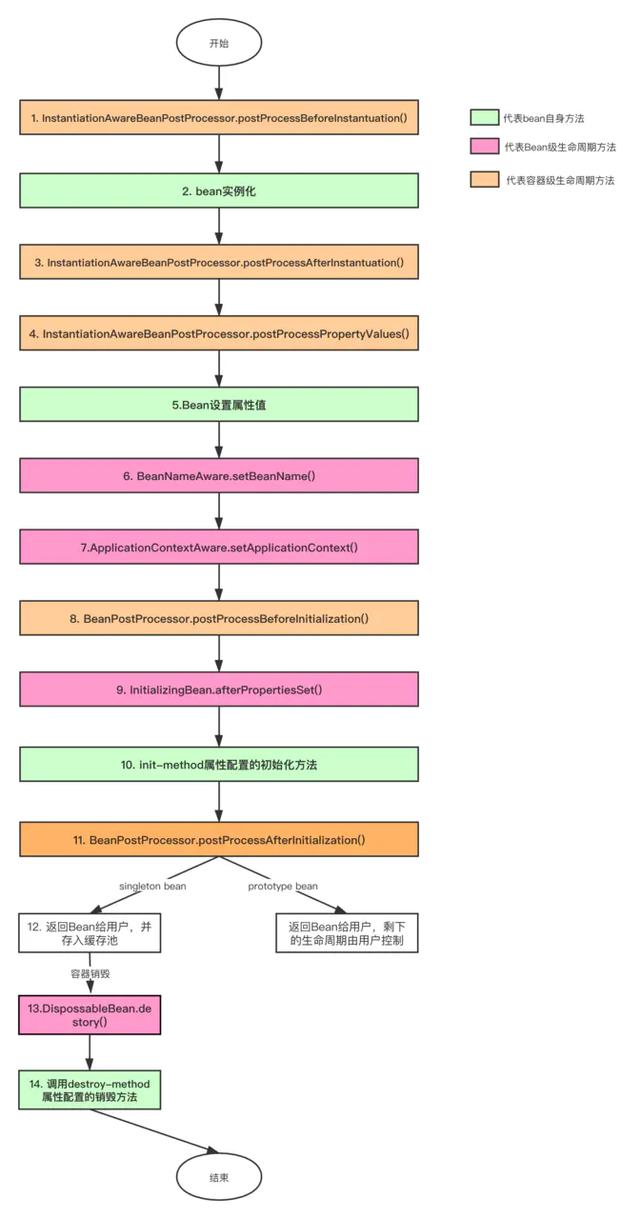Bean的生命周期
我们知道对于普通的java对象来说,它们的生命周期就是
- 实例化
- 不再使用的时候通过垃圾回收机制进行回收
参考整理:https://juejin.cn/post/6844904065457979405
但是对于Bean来说却不是这样。Bean的生命周期如下图所示:

Bean 的生命周期概括起来就是 4 个阶段:
- 实例化(Instantiation)
- 属性赋值(Populate)
- 初始化(Initialization)
- 销毁(Destruction)
- 实例化:第 1 ~ 3 步,实例化一个 bean 对象;
- 属性赋值:第 4 ~ 5 步,为 bean 设置相关属性和依赖;
- 初始化:第 6 ~ 11 步,步骤较多,其中第 9 ~ 10 步为初始化操作,第 6 ~ 8 步为在初始化前执行,第 11 步在初始化后执行,该阶段结束,才能被用户使用;
- 销毁:第 13 ~ 14 步,其实在12步前还有一步:注册Destruction相关回调接口。这一步不是真正意义上的销毁(还没使用呢),而是先在使用前注册了销毁的相关调用接口,为了后面第13、14步真正销毁 bean 时再执行相应的方法。
代码解析
doCreateBean方法
下面我们结合代码来直观的看下,在 doCreateBean() 方法中能看到依次执行了这 4 个阶段:
// AbstractAutowireCapableBeanFactory.java
protected Object doCreateBean(final String beanName, final RootBeanDefinition mbd, final @Nullable Object[] args)
throws BeanCreationException {
// 1. 实例化
BeanWrapper instanceWrapper = null;
if (instanceWrapper == null) {
instanceWrapper = createBeanInstance(beanName, mbd, args);
}
Object exposedObject = bean;
try {
// 2. 属性赋值
populateBean(beanName, mbd, instanceWrapper);
// 3. 初始化
exposedObject = initializeBean(beanName, exposedObject, mbd);
}
// 4. 销毁-注册回调接口
try {
registerDisposableBeanIfNecessary(beanName, bean, mbd);
}
return exposedObject;
}initializeBean方法
由于初始化包含了第 6 ~ 11 步,较复杂,所以我们进到 initializeBean() 方法里具体看下其过程(注释的序号对应图中序号):
// AbstractAutowireCapableBeanFactory.java
protected Object initializeBean(final String beanName, final Object bean, @Nullable RootBeanDefinition mbd) {
// 6~7. 检查 Aware 相关接口并设置相关依赖
if (System.getSecurityManager() != null) {
// SecurityManager用来保障程序安全的。负责找出不安全的和敏感的指令并加以制止,并报告用户。
AccessController.doPrivileged((PrivilegedAction<Object>) () -> {
invokeAwareMethods(beanName, bean);
return null;
}, getAccessControlContext());
}
else {
invokeAwareMethods(beanName, bean);
}
// 8. BeanPostProcessor 前置处理
Object wrappedBean = bean;
if (mbd == null || !mbd.isSynthetic()) {
wrappedBean = applyBeanPostProcessorsBeforeInitialization(wrappedBean, beanName);
}
// 9. 若实现 InitializingBean 接口,调用 afterPropertiesSet() 方法
// 10. 若配置自定义的 init-method方法,则执行
try {
invokeInitMethods(beanName, wrappedBean, mbd);
}
catch (Throwable ex) {
throw new BeanCreationException(
(mbd != null ? mbd.getResourceDescription() : null),
beanName, "Invocation of init method failed", ex);
}
// 11. BeanPostProceesor 后置处理
if (mbd == null || !mbd.isSynthetic()) {
wrappedBean = applyBeanPostProcessorsAfterInitialization(wrappedBean, beanName);
}
return wrappedBean;
}destroy方法
在 invokInitMethods() 方法中会检查 InitializingBean 接口和 init-method 方法,销毁的过程也与其类似:
// DisposableBeanAdapter.java
public void destroy() {
// 13. 若实现 DisposableBean 接口,则执行 destory()方法
if (this.invokeDisposableBean) {
try {
if (System.getSecurityManager() != null) {
AccessController.doPrivileged((PrivilegedExceptionAction<Object>) () -> {
((DisposableBean) this.bean).destroy();
return null;
}, this.acc);
}
else {
((DisposableBean) this.bean).destroy();
}
}
}
// 14. 若配置自定义的 detory-method 方法,则执行
if (this.destroyMethod != null) {
invokeCustomDestroyMethod(this.destroyMethod);
}
else if (this.destroyMethodName != null) {
Method methodToInvoke = determineDestroyMethod(this.destroyMethodName);
if (methodToInvoke != null) {
invokeCustomDestroyMethod(ClassUtils.getInterfaceMethodIfPossible(methodToInvoke));
}
}
}从 Spring 的源码我们可以直观的看到其执行过程,而我们记忆其过程便可以从这 4 个阶段出发,实例化、属性赋值、初始化、销毁。其中细节较多的便是初始化,涉及了 Aware、BeanPostProcessor、InitializingBean、init-method 的概念。这些都是 Spring 提供的扩展点,其具体作用将在下一节讲述。
扩展点的作用
Aware 接口
若 Spring 检测到 bean 实现了 Aware 接口,则会为其注入相应的依赖。所以通过让bean 实现 Aware 接口,则能在 bean 中获得相应的 Spring 容器资源。
Spring 中提供的 Aware 接口有:
- BeanNameAware:注入当前 bean 对应 beanName;
- BeanClassLoaderAware:注入加载当前 bean 的 ClassLoader;
- BeanFactoryAware:注入 当前BeanFactory容器 的引用。
其代码实现如下:
// AbstractAutowireCapableBeanFactory.java
private void invokeAwareMethods(final String beanName, final Object bean) {
if (bean instanceof Aware) {
if (bean instanceof BeanNameAware) {
((BeanNameAware) bean).setBeanName(beanName);
}
if (bean instanceof BeanClassLoaderAware) {
((BeanClassLoaderAware) bean).setBeanClassLoader(bcl);
}
if (bean instanceof BeanFactoryAware) {
((BeanFactoryAware)bean).setBeanFactory(AbstractAutowireCapableBeanFactory.this);
}
}
}以上是针对 BeanFactory 类型的容器,而对于 ApplicationContext 类型的容器,也提供了 Aware 接口,只不过这些 Aware 接口的注入实现,是通过 BeanPostProcessor 的方式注入的,但其作用仍是注入依赖。
- EnvironmentAware:注入 Enviroment,一般用于获取配置属性;
- EmbeddedValueResolverAware:注入 EmbeddedValueResolver(Spring EL解析器),一般用于参数解析;
- ApplicationContextAware(ResourceLoader、ApplicationEventPublisherAware、MessageSourceAware):注入 ApplicationContext 容器本身。
其代码实现如下:
// ApplicationContextAwareProcessor.java
private void invokeAwareInterfaces(Object bean) {
if (bean instanceof EnvironmentAware) {
((EnvironmentAware)bean).setEnvironment(this.applicationContext.getEnvironment());
}
if (bean instanceof EmbeddedValueResolverAware) {
((EmbeddedValueResolverAware)bean).setEmbeddedValueResolver(this.embeddedValueResolver);
}
if (bean instanceof ResourceLoaderAware) {
((ResourceLoaderAware)bean).setResourceLoader(this.applicationContext);
}
if (bean instanceof ApplicationEventPublisherAware) {
((ApplicationEventPublisherAware)bean).setApplicationEventPublisher(this.applicationContext);
}
if (bean instanceof MessageSourceAware) {
((MessageSourceAware)bean).setMessageSource(this.applicationContext);
}
if (bean instanceof ApplicationContextAware) {
((ApplicationContextAware)bean).setApplicationContext(this.applicationContext);
}
}BeanPostProcessor
BeanPostProcessor 是 Spring 为修改 bean提供的强大扩展点,其可作用于容器中所有 bean,其定义如下:
public interface BeanPostProcessor {
// 初始化前置处理
default Object postProcessBeforeInitialization(Object bean, String beanName) throws BeansException {
return bean;
}
// 初始化后置处理
default Object postProcessAfterInitialization(Object bean, String beanName) throws BeansException {
return bean;
}
}常用场景有:
对于标记接口的实现类,进行自定义处理。例如上一节中所说的ApplicationContextAwareProcessor,为其注入相应依赖;再举个例子,自定义对实现解密接口的类,将对其属性进行解密处理;
为当前对象提供代理实现。例如 Spring AOP 功能,生成对象的代理类,然后返回。
// AbstractAutoProxyCreator.java public Object postProcessBeforeInstantiation(Class<?> beanClass, String beanName) { TargetSource targetSource = getCustomTargetSource(beanClass, beanName); if (targetSource != null) { if (StringUtils.hasLength(beanName)) { this.targetSourcedBeans.add(beanName); } Object[] specificInterceptors = getAdvicesAndAdvisorsForBean(beanClass, beanName, targetSource); Object proxy = createProxy(beanClass, beanName, specificInterceptors, targetSource); this.proxyTypes.put(cacheKey, proxy.getClass()); // 返回代理类 return proxy; } return null; }
InitializingBean 和 init-method
InitializingBean 和 init-method 是 Spring 为 bean 初始化提供的扩展点。
InitializingBean接口 的定义如下:
public interface InitializingBean {
void afterPropertiesSet() throws Exception;
}在 afterPropertiesSet() 方法写初始化逻辑。
InitializingBean.afterPropertiesSet方法,初始化bean的时候执行,可以针对某个具体的bean进行配置。afterPropertiesSet 必须实现 InitializingBean接口。实现 InitializingBean接口必须实现afterPropertiesSet方法。
指定 init-method 方法,指定初始化方法:
<?xml version="1.0" encoding="UTF-8"?>
<beans xmlns="http://www.springframework.org/schema/beans"
xmlns:xsi="http://www.w3.org/2001/XMLSchema-instance"
xsi:schemaLocation="http://www.springframework.org/schema/beans http://www.springframework.org/schema/beans/spring-beans.xsd">
<bean id="demo" class="com.chaycao.Demo" init-method="init()"/>
</beans>DisposableBean 和 destory-method 与上述类似,就不描述了。
总结
最后总结下如何记忆 Spring Bean 的生命周期:
- 首先是实例化、属性赋值、初始化、销毁这 4 个大阶段;
- 再是初始化的具体操作,有 Aware 接口的依赖注入、BeanPostProcessor 在初始化前后的处理以及 InitializingBean 和 init-method 的初始化操作;
- 销毁的具体操作,有注册相关销毁回调接口,最后通过DisposableBean 和 destory-method 进行销毁。


